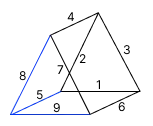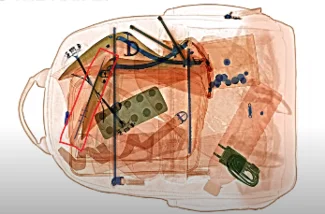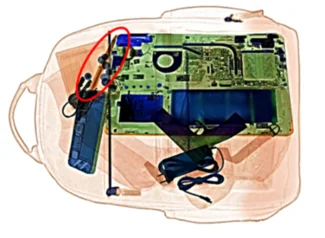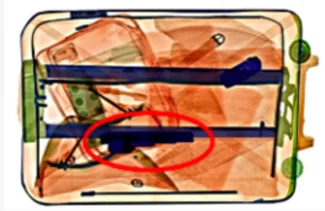Last Update: October 2025
The Transportation Security Administration (TSA) CBT test is your first screening step to become a TSA officer. In the past year, the new TSA test version was introduced, featuring a shorter 20-45 min version of a 2D to 3D interpretation test, along with two short exams.
Both the new TSA CBT test and the former TSA X-Ray test and English skills assessment evaluate your ability to process visual information. The TSA computer-based test includes a 2D to 3D interpretation test, which requires mentally rotating flat images into 3D representations, while the TSA X-Ray test assesses your ability to identify specific items in X-ray luggage scans.
We recommend practicing the new TSA test prep materials, as all testing centers are transitioning to the updated format. The practice tests in our TSA test preparation pack are designed to simulate the exact TSA CBT exam questions, as well as the former TSA X-ray test and TSA English test, which have been administered throughout the year:
- New TSA Test Practice Questions – Practice every exam question, including TSA 2D to 3D interpretation tests, with detailed answers and solving techniques.
- TSA X-Ray Test Questions – Learn to analyze X-ray images and determine whether specific objects, such as weapons or electronics, are in the luggage.
- TSA CBT English Test Questions – Improve English proficiency in reading comprehension, vocabulary, and writing skills.
- Alternative TSA Tests: Shape folding, dot connections, image matching (16 tests)
- TSA X-Ray (Legacy): Weapons, items, electronics + study guide (42 tests)
- English Skills (Legacy): Reading, vocabulary, grammar, writing (30 tests)
What to Expect on the TSA CBT?
The TSA computer-based test (CBT) you receive may be one of two versions:
- New TSA CBT Test – This version lasts 25-45 minutes and contains three aptitude sections: TSA 2D to 3D interpretation test, image matching, and number-letter connections.
- Legacy TSA CBT X-Ray and English Test – A 2.5-hour test with five sections, including 100 images in the TSA X-ray Object Recognition Test (ORT) and 50-60 English language questions. The test is taken at a TSA testing center (not available for home testing).
Ace your Test and Land the Job!
Start preparing today with our TSA test prep and boost your chances of success!
The New TSA Test Version - Skills Tests
This version of the CBT exam lasts about 20-45 minutes and includes 3 test sections that assess spatial awareness, attention, and processing speed.
1. The TSA 2D to 3D Interpretation Test
This is the most challenging part of the TSA CBT test, where you will be presented with 2D images and asked to select the correct 3D shape.
For example, the following question is taken from our complete TSA Prep:
TSA 2D to 3D Interpretation Sample Question
Which of the possible options represents the shape in its folded form?

2. Connecting numbers and letters
This part requires scanning number and letter circles and connecting them according to their order:
- First, connect number circles according to the numerical order (1-2-3...).
- Then, connect letter circles according to their order (A-B-C...)
- Finally, both number and letter circles will appear. You will be required to connect a sequence of number-letter by order (1-A-2-B-3-C...)
The challenge in this test is connecting the sequence quickly (without compromising on accuracy), since you will be graded depending on your speed.
3. Image Matching
You will be presented with an image and asked to select the correct match from five possible answers.
The TSA X-Ray Test [Legacy]: Overview, Sample Questions, and Tips
The TSA X-ray test, also known as the image interpretation test, requires you to inspect luggage scans for specific objects.
TSA X-Ray Sample Questions
Question 1
Can you see a weapon in this X-ray scan?

Some items can appear at an angle that makes them almost impossible to recognize. To prepare yourself for those images, you need to go over all the popular items and learn their shape from different angles. This kind of preparation is crucial to passing the exam.
In the TSA CBT practice pack, you’ll get a guide that will show you the items in various directions along with practice questions as well.
Question 2
Is there a grenade in this bag?

When the bag is cluttered, the objects can overlap, making it difficult to distinguish between them. The best approach for coping with these kinds of images is to look for the unique features of the target item. You need to become an expert in identifying the parts of a range of weaponry and other popular targets.
Question 3
Can you identify a pen in this X-ray image?

Question 4

Scan this suitcase and decide whether:
Understanding the meaning of colors is extremely helpful in preparing for the X-ray section since it allows you to become familiar with the characteristics of the targeted objects. The color indicates the density of the scanned items. The denser the material, the darker it will appear.
In the TSA practice pack, you’ll find more accurate questions for this category that mimic the real exam. So you won’t encounter any surprises on your TSA exam!
To get a good grasp of the X-ray section and become a master at identifying objects in these images, visit our thorough TSA X-ray test guide.
Ready to Boost your chances?
Get the practice you need to ace the TSA CBT test—start now!
The Main Challenges of the TSA X-ray Test
Firstly, some questions are objectively hard:
- The items might be overlapping or rotated at odd angles, which makes them hard to recognize.
- In black and white images, the items you are looking for are visible and easily found. But for colorful scans - understanding the X-ray color principles is complex. Especially when trying to recognize items that have multiple color combinations.
- Some items just can’t be detected, unless you know how they look on an X-ray in advance.
Secondly, there is a strict time limit. You will have only 15 seconds to look through the luggage and find objects such as weapons, bottles, drugs, or electronics.
And lastly – the TSA CBT exam is super long. It is an exhausting 2.5 hours, which makes it difficult to stay fresh and focused throughout the whole time.
Why Does the TSA Use This Test?
The TSA test ensures candidates can maintain airport security and protect travelers. Along with strong English skills, TSA officers must quickly recognize dangerous objects, prohibited items, and common objects such as electronics and shoes. Similar tests are used by GardaWorld and other security service companies.
The TSA Writing Skills Assessment [Legacy]
The TSA Written Skills Assessment, also known as the TSA CBT English test, is a multiple-choice test with 50-60 questions given with strict time constraints. This section evaluates your proficiency level in English using three categories:
Reading Comprehension
The TSA CBT reading comprehension section evaluates your speed-reading ability, general attention to detail, and overall grasp of the language. Each question contains a short paragraph followed by multiple-choice questions.
The task itself is not very complicated, but you need to practice reading quickly to successfully answer each question correctly within approximately 90 seconds.
Reading Comprehension Sample Question
🕑 Let’s try to solve this question in under 90 seconds:
>It's little wonder Russians are toasting oil: These are boom times. Global oil prices have increased tenfold since 1998, and Russia has pulled ahead of Saudi Arabia as the world's top crude oil producer. The Kremlin's budget now overflows with funds for new schools, roads, and national defense projects, and Moscow's nouveau riche are plunking down millions of dollars for mansion-scale "dachas."
The Russians now produce crude oil because:
Vocabulary
Here, your vocabulary knowledge and spelling capabilities will be assessed. You will be given a word and asked to find its synonym or opposite word from several options.
To succeed in this section, you need to revise lists of common synonyms, antonyms (words having opposite meanings), homophones (words that sound alike but have different spellings and meanings), and commonly misspelled words.
Vocabulary Sample Question
Try this question:
IMPERIOUS is the opposite of:
Written Communication
On those questions, you will be provided with a sentence structure and asked to fill in the blanks. The twist is that you will be provided with a list of word pairs. Some will be appropriate for the blanks but with spelling errors, while other pairs will not be correct at all.
Written Communication Sample Question
Here is an example:
By ________ the fossil remains of animals, paleontologists can learn much about their ________.
In the preparation pack, you’ll find 19 tests with answers and detailed explanations necessary to increase the speed and accuracy of your reading, grammar skills, and word usage.
For additional sample questions and practice tips, visit our TSA CBT English test guide.
How to Prepare for the TSA Test?
To ensure you score high on the TSA test and get into the “Best Qualified” category, make sure to practice the new TSA test version, and most importantly- the challenging 2D to 3D questions. our psychometric experts' team has created a valuable preparation pack customized for the new TSA exam and its challenges:
- Exclusive practice for the new TSA Test- includes 2d to 3d interpretation practice tests with detailed answers and solving techniques enabling you to tackle these questions confidently on test day.
- Timed TSA practice tests, resembling the actual test as closely as possible. It will help you get used to the demanding time constraints while reducing your anxiety. That way, you’ll come to the test calm and ready to succeed.
- TSA study guide and practice tests for the X-ray and English TSA exam- to ensure you are all covered we have kept the legacy TSA practice materials, with tips and tricks to interpret the X-ray images easily (how to recognize different materials, identify objects and threats, and eliminate distractions).
New TSA Test Version Practice
• 2D to 3D shape folding- 3 tests + 3 extra practice tests.
• Connecting the dots- 5 practice tests
• Image matching- 4 practice tests
TSA CBT X-Ray Practice [Legacy Format]
• Weapons: 14 tests
• Toys, pens, keys, shoes: 10 tests
• Water bottles & tools: 9 tests
• Electronics (cellphones & more): 9 tests
• X-Ray analysis study guide
TSA English Skills Practice [Legacy Format]
• Reading comprehension: 11 tests
• English (Vocabulary, Synonyms, Antonyms, Spelling): 17 tests
• Writing Skills (fault finding): 2 tests
To get a glimpse of our preparation pack, try a free TSA test sample (for both new TSA test and former X-ray & English exam)
TSA Test Results Quick Facts
After the calculation of your test score, you will be placed into one of 3 categories:
- Best qualified - candidates in this category are the first to get a job offer.
- Highly qualified – those in this category are chosen second after the ‘best qualified ’ candidates.
- Qualified - Passed all selection criteria successfully, but will be picked only after those in the two higher categories fill up all available positions.
What Is a Good Score for TSA?
If you got into the TSA CBT Test “best qualified” category, then you have done extremely well. Scoring high is crucial because those who are placed in the best-qualified category have the highest chance of getting the job they want.
The other applicants might have to wait for a job offer for several months up to 2 years.
You may think you can just take the TSA exam again, but that’s not possible. You can’t retake the test during the waiting period to improve your score.
How to Score High on the Test?
To get a really high score, you must understand all question variants and also how to avoid all the traps that most candidates fall into.
We recommend putting in effort to ensure that you pass the test with the highest score you can achieve. Give yourself the competitive edge you need to get a job offer quickly.
To learn more about the TSA scores, visit our complete TSA scoring guide.
What to Expect in the Rest of the TSA Hiring Process?
To get to the TSA CBT test, your first step is to apply for a position online. If your application is accepted, you will go through stages of screening to become a transportation security administration agent, which include:
- The CBT test
- Color vision test
- Medical evaluation
- Personal interview
- Drug test
- Medical condition test
- Background investigation (Criminal history will be subjected to a thorough investigation)
To learn more about the TSA recruitment process and understand exactly what happens in each stage, visit our TSA hiring process page.
TSA FAQ
Your final score is based on the number of correct answers. There is no penalty for wrong answers. So, if you're not sure what is the correct answer is, and you are running out of time - take an educated guess. Leave no answer blank on the X-ray test or the writing skills test.
Only US citizens who are at least eighteen years old and have a valid high school diploma or equivalent will take the TSA-CBT examination.
Only 30% of test-takers pass the TSA CBT test. In certain cases, those who pass the exam will be asked to retake it to prove that they passed because of their visual and cognitive ability and not by chance.
After you pass the TSA CBT, you'll receive a Contingent Job Offer and you'll get 14 days to complete several forms, such as the E86 National Security Questionnaire. Additionally, the TSA will run a credit check on you. You must pass this step to advance to the next hiring stages.
If you fail the TSA exam once, you must wait six months before applying for any TSO positions. If you fail the TSA CBT twice, you won’t be able to take the exam again. This means that you will no longer be able to apply for a TSO position.
A TSO paid approximately $17 per hour. It changes slightly between different airports.
You can dress “smart casual” for your TSA CBT test. You need to look professional and presentable. However, there's no need to dress up. It's fine to wear a shirt and tie.









